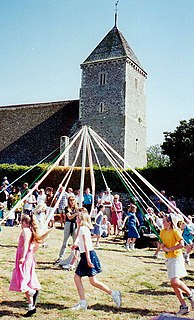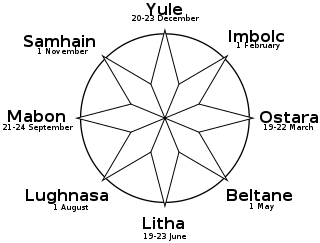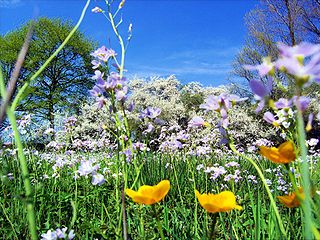Spring Day is a holiday marking the coming of the spring season, which takes place in different countries, on varying dates.
Spring Day is a holiday marking the coming of the spring season, which takes place in different countries, on varying dates.
Albania celebrates the lunar Spring Day, the so-called Summer Day (Albanian : Dita e Verës or Dita e Luleve), on 14 March, and in 2004 it became a national holiday. It is an old pagan practice, particularly popular in the city of Elbasan, Central Albania.
According to some sources, Dita e Verës derives from the Arbëreshë, an Albanian community that lives in Italy since the fifteenth century. On 14 March, the Arbëreshë of the Italian coast, collect a tuft of grass roots and soil, bringing it home to commemorate the anniversary of their emigration from Albania. In fact, some sources date back this celebration to the ancient Illyria. At that time, the feast was celebrated on 1 March, which according to the Julian calendar, corresponded to the first day of the year.
Pilgrimages were made to the highest peaks in the Albanian mountains to be as close as possible to the Sun God and pray for the goodness and prosperity of the new year. The great fire crossed by men and young people symbolized the end of winter. Instead, wreaths and garlands on the doors of the houses wished good luck. The purity of the celebration has weakened over the centuries but came to this day thanks to the tradition preserved in the city of Elbasan.
The ritual of the Dita e Verës begins on the previous day with the preparation of sweets: the revani and ballakume, the blended butter, sugar, corn flour and egg yolks cooked in a wood oven. During the evening ballakume, dried figs, walnuts, turkey legs, boiled eggs, Simit (a typical sandwich of the city) are distributed to members of the family. The oldest woman of the house remains awake at night and goes from room to room to put down grass on the cushions of couples, young people and children, a ritual that symbolizes the regeneration and quickening.
On the morning of 14 March, the elderly leave the door open as a sign of generosity, a pitcher filled with fresh water and take home a clump of green grass. The youngest fertilizes the orange and olive trees, but the smaller ones are the first to make the "lucky" visits to neighbors and relatives who give them turkey legs, dried figs and nuts. Finally lunch on 14 March, should be eaten outdoors in the company of friends and relatives.
Estonia celebrates Spring Day on 1 May.
Iran celebrates Spring day at 21 March as its only new year celebration. This national celebration is called Nowruz in Iran.
Bangladesh celebrates Spring day on 13 February as the first of the month of Falgun. It is the beginning of the Boshonto, the Spring season for Bengalis.
Argentina celebrates the beginning of spring, conventionally, on 21 September, one or two days before the actual spring equinox. This day also marks Students' Day.
Though this is not a work-free public holiday, it coincides with Students' Day, which is a no-school day for students on all the levels of the education system. The holiday is therefore mostly observed and dominated by teenagers and young adults, who massively take over public parks, beaches and other outdoor venues in the larger cities, and enjoy sports or picnics.
Local administrations usually offer the public a number of entertainment shows, such as free rock concerts. In recent years security operations have been staged to avoid incidents such as fights and vandalism, as well as controls to curb the consumption of alcoholic beverages.
Paraguay celebrates the beginning of spring on 21 September, one or two days before the actual spring equinox. This day also marks Youth Day.
Uruguay celebrates the beginning of spring, on 21 September, one or two days before the actual spring equinox.
Bolivia celebrates the beginning of spring, on 21 September, it is also Students' day and "día del amor", on this day youth will send cards, chocolates and flowers to their friends, mates, or lovers.
South Africa Celebrates spring Day on the 1 September. Spring day traditions in South Africa range from having a traditional braai to shaving your head and beard. In many townships, children celebrate Spring Day by spraying each other with water. However, in some urban settlements everyone participates.

Easter, also called Pascha or Resurrection Sunday, is a Christian festival and cultural holiday commemorating the resurrection of Jesus from the dead, described in the New Testament as having occurred on the third day of his burial following his crucifixion by the Romans at Calvary c. 30 AD. It is the culmination of the Passion of Jesus, preceded by Lent, a 40-day period of fasting, prayer, and penance.
March is the third month of the year in both the Julian and Gregorian calendars. It is the second of seven months to have a length of 31 days. In the Northern Hemisphere, the meteorological beginning of spring occurs on the first day of March. The March equinox on the 20 or 21 marks the astronomical beginning of spring in the Northern Hemisphere and the beginning of autumn in the Southern Hemisphere, where September is the seasonal equivalent of the Northern Hemisphere's March.

May Day is a European festival of ancient origins marking the beginning of summer, usually celebrated on 1 May, around halfway between the spring equinox and summer solstice. Festivities may also be held the night before, known as May Eve. Traditions often include gathering wildflowers and green branches, weaving floral garlands, crowning a May Queen, and setting up a Maypole, May Tree or May Bush, around which people dance. Bonfires are also part of the festival in some regions. Regional varieties and related traditions include Walpurgis Night in central and northern Europe, the Gaelic festival Beltane, the Welsh festival Calan Mai, and May devotions to the Blessed Virgin Mary. It has also been associated with the ancient Roman festival Floralia.

New Year is the time or day currently at which a new calendar year begins and the calendar's year count increments by one. Many cultures celebrate the event in some manner. In the Gregorian calendar, the most widely used calendar system today, New Year occurs on January 1. This was also the first day of the year in the original Julian calendar and the Roman calendar.

The Wheel of the Year is an annual cycle of seasonal festivals, observed by many modern pagans, consisting of the year's chief solar events and the midpoints between them. While names for each festival vary among diverse pagan traditions, syncretic treatments often refer to the four solar events as "quarter days", with the four midpoint events as "cross-quarter days". Differing sects of modern paganism also vary regarding the precise timing of each celebration, based on distinctions such as lunar phase and geographic hemisphere.

Nowruz is the Persian-language term for the day of the Iranian New Year, also known as the Persian New Year. It begins on the spring equinox and marks the beginning of Farvardin, the first month of the Solar Hijri calendar. The day is celebrated worldwide by various ethnolinguistic groups and falls on or around the date of 21 March on the Gregorian calendar.
Vernal Equinox Day is a public holiday in Japan that occurs on the date of the Northward equinox in Japan Standard Time, usually March 20 or 21. The date of the holiday is not officially declared until February of the previous year, due to the need for recent astronomical measurements.

Spring, also known as springtime, is one of the four temperate seasons, succeeding winter and preceding summer. There are various technical definitions of spring, but local usage of the term varies according to local climate, cultures and customs. When it is spring in the Northern Hemisphere, it is autumn in the Southern Hemisphere and vice versa. At the spring equinox, days and nights are approximately twelve hours long, with daytime length increasing and nighttime length decreasing as the season progresses until the Summer Solstice in June and December.

Holi is a popular ancient Hindu festival, also known as the Festival of Spring, the Festival of Colours or the Festival of Love. The festival celebrates the eternal and divine love of Radha Krishna. It also signifies the triumph of good over evil, as it celebrates the victory of Lord Vishnu as Narasimha Narayana over Hiranyakashipu. It originated and is predominantly celebrated in the Indian subcontinent but has also spread to other regions of Asia and parts of the Western world through the South Asian diaspora.

The March equinox or northward equinox is the equinox on the Earth when the subsolar point appears to leave the Southern Hemisphere and cross the celestial equator, heading northward as seen from Earth. The March equinox is known as the vernal equinox in the Northern Hemisphere and as the autumnal equinox in the Southern Hemisphere.

Santa Cristina Gela is an Arbëreshë village in the Metropolitan City of Palermo in Sicily.
Dita e Verës or Verëza is an Albanian spring festival and pagan holiday celebrated in Albania on March 14 of the Gregorian calendar. In the old Albanian calendar, Verëza corresponds to the first three days of the new year and marks the end of the winter season and the beginning of the summer season on the spring equinox. Dita e Verës has its roots in traditional Albanian, Greek and Roman religions. Another festival of the spring equinox observed in Albania is Nowruz, celebrated on March 22.
Lists of holidays by various categorizations.

Hıdırellez or Hıdrellez is a folk holiday celebrated as the day on which the Prophets Al-Khidr (Hızır) and Elijah (İlyas) met on Earth. Hıdırellez starts on May 5 night and falls on May 6 in the Gregorian calendar and April 23 in the Julian calendar. It is celebrated in Turkey, Crimea, Syria, Iraq and the Balkans. It celebrates the arrival of spring. People pray on this day whatever their wishes are. They make symbols with stone or draw of their wishes.

A birthday is the anniversary of the birth of a person, or figuratively of an institution. Birthdays of people are celebrated in numerous cultures, often with birthday gifts, birthday cards, a birthday party, or a rite of passage.
Novruz in Azerbaijan is a traditional holiday which celebrates the Persian New Year and the coming of Spring. When Azerbaijan was part of the Soviet Union, the celebration of Novruz was generally unofficial and at times even prohibited. Currently in Azerbaijan, Novruz is treated as an official public holiday. In accordance with Article 105 of the Labour Code of Azerbaijan passed in 2006, workers receive five days off for Novruz. After neighbouring Iran, Azerbaijan hosts the longest observance and number of public days related to Novruz, with a total of 5 days.

Ballokume is an Albanian cookie originating in the city of Elbasan, which is popular throughout Albania and Albanian communities. It is traditionally eaten on Dita e Verës, an Albanian pagan holiday celebrated on 14 March. It is sometimes called kulaç me finj, as it may optionally contain finj, a mixture of ashes from a wood stove boiled in water.

Navruz is celebrated widely in Uzbekistan. It is the day of the vernal equinox, and marks the beginning of spring in the Northern Hemisphere. It has been celebrated on the territory corresponding to modern-day Uzbekistan for at least two thousand years. Nowruz widely celebrated on a vast territory of Central Asia and ritual practice acquired its special features. The festival was legitimized by prayers at mosques, and visits to the mazars of Muslim saints and to sacred streams. In the Emirate of Bukhara, a broad official celebration of Nowruz was started by Amir Muzaffar, who sought to strengthen the image of the Manghyt dynasty during the crisis of political legitimacy.